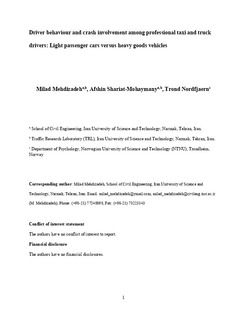| dc.contributor.author | Mehdizadeh, Milad | |
| dc.contributor.author | Shariat-Mohaymany, Afshin | |
| dc.contributor.author | Nordfjærn, Trond | |
| dc.date.accessioned | 2019-05-06T08:08:39Z | |
| dc.date.available | 2019-05-06T08:08:39Z | |
| dc.date.created | 2018-12-11T15:45:09Z | |
| dc.date.issued | 2019 | |
| dc.identifier.citation | Transportation Research Part F: Traffic Psychology and Behaviour. 2019, 62 86-98. | nb_NO |
| dc.identifier.issn | 1369-8478 | |
| dc.identifier.uri | http://hdl.handle.net/11250/2596537 | |
| dc.description.abstract | Professional drivers are drivers whose profession is to drive a vehicle such as truck and taxi for working purposes. However, these drivers constitute a heterogeneous group and generalizing assumptions about risky driving behaviour across the entire group might be misleading. The current study aimed to investigate similarities and differences of self-reported risky driving behaviour and crash involvement among different groups of professional drivers. Two rather large samples of taxi drivers obtained from 20 taxi stations in two cities (n = 381) and heavy goods vehicles (truck) drivers obtained from a roadside survey in 10 provinces (n = 785) completed the same 27-item Driver Behaviour Questionnaire (DBQ) in Iran. Principal component analysis showed that the DBQ segmented into four dimensions both among taxi and truck drivers. Further, a multi-group confirmatory factor analysis (MGCFA) supported strong measurement invariance in the DBQ factor structure across the two samples. The results showed that taxi drivers were more likely than truck drivers to commit errors as well as ordinary and aggressive violations. A one unit increase in ordinary and aggressive violations increased the probability of having experienced a traffic crash in the last year by 69% and 98% for taxi drivers, respectively, and 37% and 42% among truck drivers, respectively. This highlights that driving violations increased the probability of crash involvement almost twice as much among taxi drivers compared to truck drivers. Policymakers could target ordinary and aggressive violations by establishing better driving training and by improving the licensing procedures among professional drivers. | nb_NO |
| dc.language.iso | eng | nb_NO |
| dc.publisher | Elsevier | nb_NO |
| dc.rights | Attribution-NonCommercial-NoDerivatives 4.0 Internasjonal | * |
| dc.rights.uri | http://creativecommons.org/licenses/by-nc-nd/4.0/deed.no | * |
| dc.title | Driver behaviour among professional taxi and truck drivers: Light passenger cars versus heavy goods vehicles | nb_NO |
| dc.type | Journal article | nb_NO |
| dc.type | Peer reviewed | nb_NO |
| dc.description.version | acceptedVersion | nb_NO |
| dc.source.pagenumber | 86-98 | nb_NO |
| dc.source.volume | 62 | nb_NO |
| dc.source.journal | Transportation Research Part F: Traffic Psychology and Behaviour | nb_NO |
| dc.identifier.doi | 10.1016/j.trf.2018.12.010 | |
| dc.identifier.cristin | 1641821 | |
| dc.description.localcode | © 2019. This is the authors’ accepted and refereed manuscript to the article. Locked until 7.1.2021 due to copyright restrictions. This manuscript version is made available under the CC-BY-NC-ND 4.0 license http://creativecommons.org/licenses/by-nc-nd/4.0/ | nb_NO |
| cristin.unitcode | 194,67,40,0 | |
| cristin.unitname | Institutt for psykologi | |
| cristin.ispublished | true | |
| cristin.fulltext | original | |
| cristin.fulltext | postprint | |
| cristin.qualitycode | 1 | |

